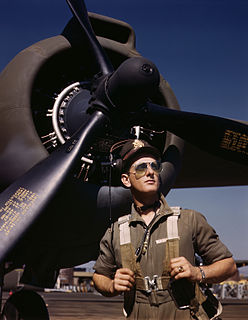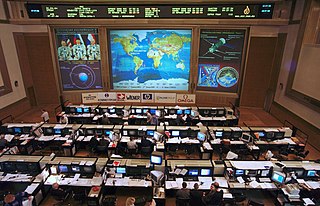
Aviation, or air transport, refers to the activities surrounding mechanical flight and the aircraft industry. Aircraft includes fixed-wing and rotary-wing types, morphable wings, wing-less lifting bodies, as well as lighter-than-air craft such as balloons and airships.

An unmanned aerial vehicle (UAV), commonly known as a drone, is an aircraft without a human pilot onboard. UAVs are a component of an unmanned aircraft system (UAS); which include a UAV, a ground-based controller, and a system of communications between the two. The flight of UAVs may operate with various degrees of autonomy: either under remote control by a human operator or autonomously by onboard computers.

An aircraft pilot or aviator is a person who controls the flight of an aircraft by operating its directional flight controls. Some other aircrew members, such as navigators or flight engineers, are also considered aviators, because they are involved in operating the aircraft's navigation and engine systems. Other aircrew members, such as flight attendants, mechanics and ground crew, are not classified as aviators.
Free flight is a developing air traffic control method that uses no centralized control. Instead, parts of airspace are reserved dynamically and automatically in a distributed way using computer communication to ensure the required separation between aircraft. This new system may be implemented into the U.S. air traffic control system in the next decade. Its potential impact on the operations of the national airspace system is disputed, however.

Airservices Australia is an Australian Government owned corporation, responsible for providing safe, secure, efficient and environmentally responsible services to the aviation industry within the Australian Flight Information Region (FIR). Airservices Australia has international partnerships with ICAO, CANSO and IATA. The agency also maintains a close relationship with the Australian Defence Force through the Future Service Delivery business group, which will see the acquisition of a joint civil-military air traffic management system under the OneSKY Australia Program.

In air traffic control, an area control center (ACC), also known as a center or en-route center, is a facility responsible for controlling aircraft flying in a particular volume of airspace at high altitudes between airport approaches and departures. In the US, such a center is referred to as an air route traffic control center (ARTCC).

On 10 September 1976, British Airways Flight 476, a Hawker Siddeley Trident en route from London to Istanbul, collided mid-air near Zagreb, Yugoslavia, with Inex-Adria Aviopromet Flight 550, a Douglas DC-9 en route from Split, Yugoslavia, to Cologne, West Germany. The collision was the result of a procedural error on the part of Zagreb air traffic controllers.

A non-towered airport is an airport without a control tower, or air traffic control (ATC) unit. The vast majority of the world's airports are non-towered. In the United States there are close to 20,000 non-towered airports compared to approximately 500 airports with control towers. Airports with a control tower without 24/7 ATC service follow non-towered airport procedures when the tower is closed but the airport remains open, for example at night.
A mid-air collision is an aviation accident in which two or more aircraft come into unplanned contact during flight. Owing to the relatively high velocities involved and the likelihood of subsequent impact with the ground or sea, very severe damage or the total destruction of at least one of the aircraft involved usually results.

A transponder is an electronic device that produces a response when it receives a radio-frequency interrogation. Aircraft have transponders to assist in identifying them on air traffic control radar. Collision avoidance systems have been developed to use transponder transmissions as a means of detecting aircraft at risk of colliding with each other.

Air traffic controller is a United States Navy occupational rating.
Airways New Zealand is the sole Air Traffic Service provider in New Zealand.

The BAE Systems HERTI is an unmanned aerial vehicle (UAV) developed by the British company BAE Systems. HERTI stands for "High Endurance Rapid Technology Insertion" and was developed in Warton, United Kingdom. The HERTI airframe is based on a motor glider designed by Jaroslaw Janowski of J&AS Aero Design, Poland. Its first flight was in December 2004 at the Australian Woomera test range where much of the test flight programme has been undertaken. HERTI was also the first UAV to fly in the UK with the flight being certified by the Civil Aviation Authority.

The Polish Air Force University is located in Deblin, eastern Poland. The Air Force University is an accredited university for the undergraduate education of officers for the Polish Air Force. It was established in the interwar period in 1927. In 2009 academy started civilian program with four faculties: airplane pilot, aircraft maintenance, air traffic control and national security. In 2011 Department of National Safety and Logistics was created, giving the full range of aviation faculties to choose.
Next Generation (NextGen) Data Communications, an element of the Next Generation Air Transportation System, will significantly reduce controller-to-pilot communications and controller workload, whilst improving safety.

ADC Airlines Flight 86 was a Nigerian domestic flight operated by ADC Airlines from Port Harcourt to Lagos. On 7 November 1996 the crew of the Boeing 727-200 operating the flight lost control of the aircraft while avoiding a mid-air collision on approach; the aircraft crashed inverted at a very high speed, killing all 144 passengers and crew on board. Investigators determined the primary cause of the accident was an air traffic control error.

Aeroflot Flight 415 was a domestic scheduled passenger flight operated by Aeroflot from Lviv to Sochi with a stopover in Simferopol. On 28 July 1962 the Antonov An-10 operating the route crashed near Gagra, Abkhaz ASSR, Georgian SSR, killing all 81 passengers and crew on board.
The Information Age is generally understood to have arrived with the Internet as it was developed through the 1970s and rolled out throughout the 1980s, and continues evolving to this day. So too the adoption of digital techniques in aviation also arrived progressively at around the same time and also continues today.

















